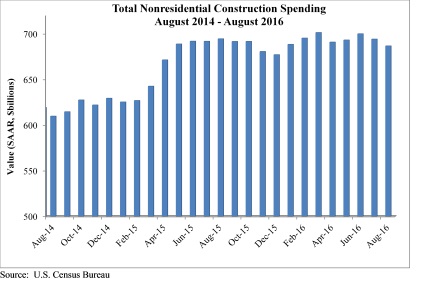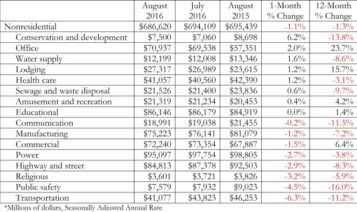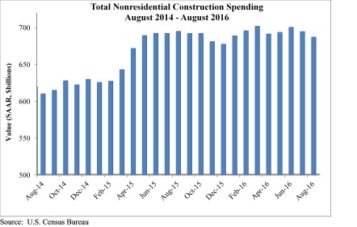
WASHINGTON, D.C. — Nonresidential construction spending fell for a second consecutive month in August, according to a recent analysis of U.S. Census Bureau released by Associated Builders and Contractors. Nonresidential spending totaled $686.6 billion on a seasonally adjusted, annualized basis for the month, 1.1 percent lower than July’s total of $694.1 billion (revised down from $701 billion) and 1.3 percent below August 2015’s figure.
Private nonresidential construction spending fell just 0.4 percent for the month, while its public sector counterpart shrank 2 percent. Four of the five largest nonresidential subsectors—power, highway and street, commercial and manufacturing—combined to fall 2.2 percent on a monthly basis.
“Stakeholders in the nation’s nonresidential construction industry have become accustomed to seeing weak spending data. However, today’s report represents a bit of a departure from previous reports,” said ABC Chief Economist Anirban Basu. “While previous weak spending reports can almost completely be explained by diminished public construction spending, today’s report also revealed emerging weakness in private spending.
“There are some noteworthy exceptions,” said Basu. “Office-related construction spending continued to surge higher, rising 2 percent for the month and up a whopping 24 percent on a year-over-year basis. Construction spending related to lodging rose 1.2 percent on a monthly basis and is nearly 16 percent higher than the year-ago level. Foreign investment in U.S. commercial real estate heavily influences these two segments, which has helped produce both higher asset prices and more construction.
“Given the passage of a federal highway bill last year, one might have expected spending growth in the highway/street and transportation categories,” said Basu. “Those expectations have been unmet thus far. Transportation-related construction spending dipped by more than 6 percent in August and by more than 11 percent on a year-over-year basis. Highway and street spending is down by more than 8 percent on a year-ago basis, and was down nearly 3 percent for the month.
“There are a number of theories at work, including the 2016 election cycle, which has led to some decision-makers putting projects on hold,” said Basu. “Government spending generally remains weak, and there are some indications that private lending standards are tightening due to a combination of growing concern among financial industry regulators and bankers that real estate bubbles are forming again in certain communities and segments.”




 Join our thriving community of 70,000+ superintendents and trade professionals on LinkedIn!
Join our thriving community of 70,000+ superintendents and trade professionals on LinkedIn! Search our job board for your next opportunity, or post an opening within your company.
Search our job board for your next opportunity, or post an opening within your company. Subscribe to our monthly
Construction Superintendent eNewsletter and stay current.
Subscribe to our monthly
Construction Superintendent eNewsletter and stay current.